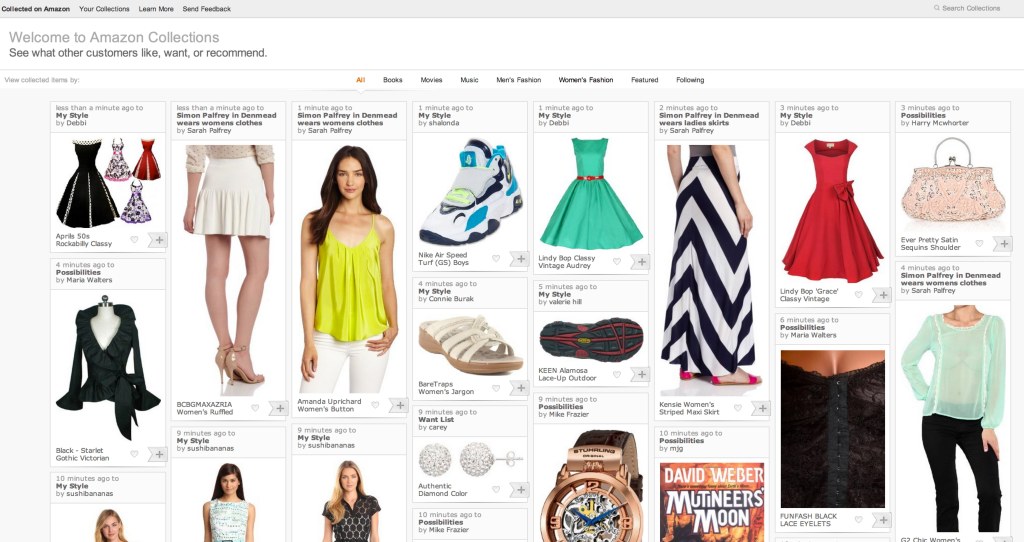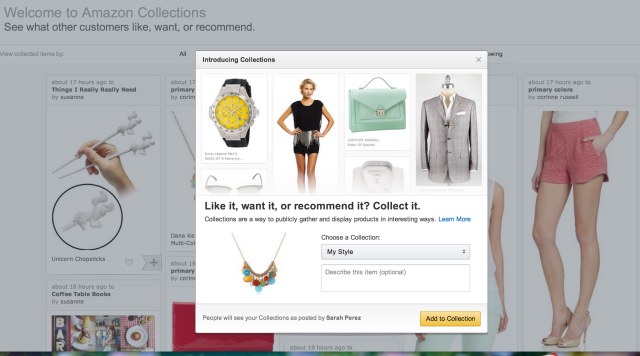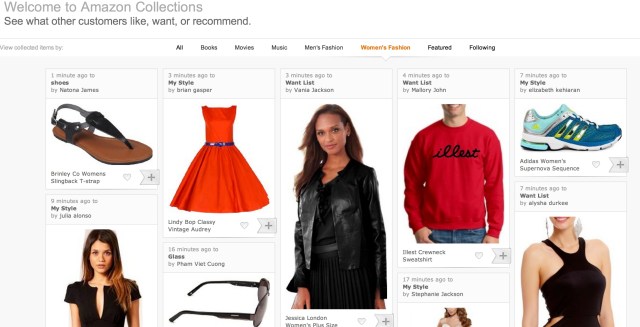Amazon has quietly launched its own direct challenger to Pinterest with the debut of a feature called “Amazon Collections.” It’s a more attractive, image-heavy website where consumers can save, share and discover new products by browsing those others have saved. Like Pinterest, users create separate lists, called Collections, such as “Want List” or “Fashion,” for example, and they can find and follow other users who share their same interests through the service.
The company had been testing this feature beginning with a number of bloggers ahead of a larger, public debut, and some of those with early access have already detailed their experiences using the site to put together outfits, or other initial impressions. Some were even paid to be advisors. The earliest references we’re seeing from beta testers writing about the service were posted in late April.
Today, the link to “Your Collections” appears in the list of options when you hover over “Your Account” from the drop-down menu on Amazon.com’s homepage, which gives the service a more prominent placement on Amazon’s site.
Initially, all users start off with a few empty collections (“My Style,” “Want List,” and “Possibilities”) but you can make your own Collections, too. To add an item to a Collection, you simply click on an “Add to Collection” button below the product image on Amazon.com’s website. However, because Collections is a new feature, this button has not yet been rolled out to all the products on the site at this time.
To work around this problem, Amazon provides a “Collect” button that can be dragged to your browser’s bookmarks bar, letting you add any product on Amazon to your collections. This does not appear to be a way to “collect” non-Amazon products at this time, though, as nothing happens when that buttons is clicked off-site.
Users can add descriptions for their saved items, edit or remove them from their lists, or even delete entire collections at once. The service also offers a way for users to browse through default categories like Books, Men’s Fashion, Movies, Music, Women’s Fashion, Featured, and more, all of which are laid out in a Pinterest-inspired image pinboard format where there’s heavy emphasis on the item photo and little other info besides the product name and a “heart” button for favoriting things. In order to see pricing and further product details, you have to click through.
Currently, Amazon Collections’ friending and following model is limited — the site shows the popular items others are pinning to which boards and when they posted those items (e.g. “3 minutes ago”), and you can then click on those users’ names in order to follow them on the service. But there doesn’t seem to be an option for discovering your friends who are on Amazon Collections, such as through address book upload or Facebook integration.
This is not Amazon’s first experiment with providing consumers with an alternative way to shop its site, we should point out. In years past, it has launched a number of other product visualization tools, like its 2008 grid-like storefront Amazon Windowshop, which later arrived on iPad in 2010, or its 2011 dabble in augmented reality via Amazon Flow. It has also worked to make the site more social, through integrations with Facebook for tracking birthdays or figuring out what things Facebook friends want as gifts.
But this is the first time Amazon has gone so far as to boldly duplicate the overall look-and-feel of a competing service, which, to some extent, validates the traction Pinterest is seeing with e-commerce referrals. The move also comes at a time when Pinterest has been beefing up its e-commerce efforts, with new tools for online retailers, including web and mobile product pins, analytics, personalized recommendations, and, just today, price alerts.
Amazon’s entry into more social, visualized product discovery may end up being bad news for another startup, Canopy, which only yesterday debuted a service that makes Amazon shopping more attractive and interactive. The company tells us they even noticed a few senior Amazon engineers using their site around two to three weeks ago and several more since, which prompted them to speed up their launch.
Facebook, too, has been going after Pinterest, with a “Collections” feature of its own, still in testing.
Amazon declined to provide comment on its plans, beyond noting that it is “always testing new functionality on the site, and “this new test feature is just one of the many ways we are working to help our customers discover and share new things.”
Post updated 8/1/13 ~6 PM ET with Amazon’s response.


































Comment